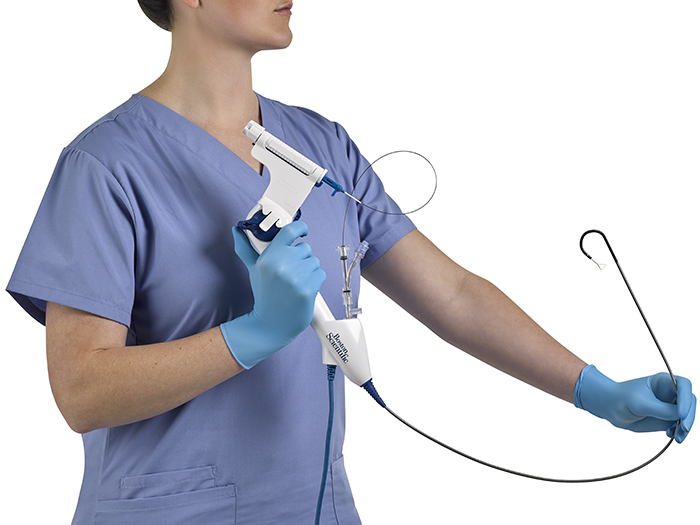*MOSES™ 2.0 Technologie umfasst alle Einstellungen und Funktionen von MOSES™ 1.0.
**Scope-1-Emissionen sind direkte Emissionen aus eigenen oder kontrollierten Quellen.
Scope-2-Emissionen sind indirekte Emissionen aus der Erzeugung von eingekaufter Energie.
Scope-3-Emissionen sind alle indirekten Emissionen (nicht in Scope 2 enthalten), die in der Wertschöpfungskette des berichtenden Unternehmens entstehen, einschließlich der vor- und nachgelagerten Emissionen.
†Labortestergebnisse stimmen möglicherweise nicht mit klinischen Ergebnissen überein. Tests im Auftrag von BSC durchgeführt. Studienmethodologie: Die Tests wurden von einer unabhängigen Drittpartei unter Anwendung der BEST™ In-vitro-Methode zur Beurteilung der Salzanhaftung an den Ureterstents durchgeführt. Insgesamt wurden 30 Proben von jeder Ureterstent-Produktfamilie sowohl mit dem sterilen Kunsturin-Modell als auch mit dem bakteriellen Infektionsmodell (n = 15 bei jedem Modell) über einen Zeitraum von zwei Wochen getestet. Das Bakterium Proteus mirabilis wurde als mikrobielles Pathogen für das Modell mit bakteriellen Infektionen aufgrund seiner bekannten Urease-Produktion und Beteiligung an der Bildung von Struvit ausgewählt.
‡Labortestergebnisse stimmen möglicherweise nicht mit klinischen Ergebnissen überein. Die Verringerung des Stent-Durometers stellt die durchschnittliche prozentuale Verringerung des Stent-Durometers von 25 °C auf 37 °C an der Luft dar.
Bilder von Nierensteinen dienen nur der Veranschaulichung. Quelle: Getty Images und Adobe Stock.
Literaturhinweise
1. Data on file with Boston Scientific.
2. Mager R, et al. Clinical outcomes and costs of reusable and single-use flexible ureterorenoscopes: a prospective cohort study. Urolithiasis. 2018 Nov;46(6):587-593.
3. Joice GA, et al. Ergonomics and procedure time of novel retrieval deployment device for single surgeon ureteroscopy. Abstract presented at EUS Annual Meeting, May 18, 2018, San Francisco, CA
4. Ibrahim A., et al. Double-Blinded Prospective Randomized Clinical Trial Comparing Regular and Moses Modes of Holmium Laser Lithotripsy. J Endourol. 2020 May;34(5):624‐8.
5. Cinman NM, et al. Associated conditions and treatment of the pelvic kidney. In: Smith AD, Badlani GH, Preminger GM, Kavoussi LR eds. Smith’s Textbook of Endourology. Blackwell Publishing;2012;(62):707-715
6. Elhilali MM, et al. Use of the Moses Technology to Improve Holmium Laser Lithotripsy Outcomes: A Preclinical Study. J Endourol. 2017 Jun;31(6):598-604.
7. Mues AC, et al. Evaluation of 24 holmium:YAG laser optical fibers for flexible ureteroscopy. J Urol. 2009 Jul;182(1):348-54.
8. Carey RI et al. Frequency of ureteroscope damage seen at a tertiary care center. J Urol. 2006 Aug;176(2):607-10.
9. Collins JW, et al. Cost analysis of flexible ureterorenoscopy. BJU Int. 2004 May;93(7):1023-6.
10. Chi T et al. Durability of flexible ureteroscopy and predictors of repair: A prospective multi-center study. Poster session presented at The European Association of Urology Annual Congress; 2016 March; Munich, Germany.
11. Carey RI and Carey MS. The Ureteroscope Matters: Matched Pari Analysis Reveals Increased Operative Time and Reoperation Associated with the Use of Refurbished Flexible Ureterosocpes from a Third Party Out-sourced Vendor. Poster session presented at: Southeast Section American Urological Association Annual Meeting; 24 March 2017; Austin, TX.
12. Hubosky et al. Defining the rate of encountering unacceptable reusable flexible ureteroscopes for immediate clinical use: 'Bad out of the Box.' Poster Session presented at The World Congress of Endourology, September 2017; Vancouver, British Columbia, Canada (MP3-10).
13. Matlaga B. Moving from four hands to two during flexible ureteroscopy with stone manipulation. Abstract presented at the World Congress of Endourology, 2018, Paris
14. Cvetic E. Communication in the perioperative setting. AORN J. 2011 Sep;94(3): 261-70.
15. Gillespie, B. M., et al. Interruptions and Miscommunications in surgery: an observational study. 2012 AORN Journal, 95(5), 576-590.
16. Clark, C. M., & Kenski, D. Promoting civility in the OR: an ethical imperative. 2016 AORN Journal, 105(1), 60-66.
17. Agarwal DK, et al. Catheter removal on the same day of holmium laser enucleation of the prostate: Outcomes of a pilot study. Urology. 2020 Dec;146:225‐9.
18. Tracey J, et al. Ureteroscopic High‐Frequency Dusting Utilizing a 120‐W Holmium Laser. J Endourol. 2018 Apr;32(4):290‐
19. Tokas T, et al. Pressure matters: intrarenal pressures during normal and pathological conditions, and impact of increased values to renal physiology. World J Urol. 2019 Jan;37(1):125-31.
20. Sutcliffe KM, et al. Communication failures: an insidious contributor to medical mishaps. Acad Med. 2004;79(2):186-194.
21. Kawahara T, et al. Ureteral Stent Encrustation, Incrustation, and Coloring: Morbidity Related to Indwelling Times J Endourol. 2012 Feb;26(2):178-82.
22. Ofstead C et al. The effectiveness of sterilization for flexible ureteroscopes: A real-world study. Am J Infect Control. 2017 Aug 1;45(8):888-895.
23. Ofstead CL. Endoscope reprocessing methods: a prospective study on the impact of human factors and automation. Gastroenterol Nurs. 2010 Jul-Aug;33(4):304-11.
24. SM Hession. Endoscope Disinfection by Orthophthalaldehyde in a Clinical Setting An Evaluation of Reprocessing Time and Costs Compared With Glutaraldehyde. Gastroenterol Nurs. 2003 May-Jun;26(3):110-4
25. Park HK, et al. The impact of ureteral stent type on patient symptoms as determined by the ureteral stent symptom questionnaire : a prospective, randomized, controlled study. J Endourol. 2015 Mar;29(3):367-71. 4
26. Davis NF, et al. Carbon Footprint in Flexible Ureteroscopy: A Comparative Study on the Environmental Impact of Reusable and Single-Use Ureteroscopes. J Endourol. 2018 Mar;32(3):214-217.
27. Pfiedler Enterprises. The care and handling of rigid and flexible scopes (an online continuing education activity). Aurora, CO, 2013.
28. Rutala WA., WeberDJ., & Healthcare Infection Control Practices Advisory Committee. Guideline for disinfection and sterilization in healthcare facilities. Atlanta, GA: Centers for Disease Control and Prevention, 2008.
29. Clemens JQ, et al. Joint AUA/SUNA white paper on reprocessing of flexible cystoscopes. The Journal of Urology. 184(6):2241-2245, 2014.
30. Smith DR, et al. Glutaraldehyde exposure and its occupational impact in the health care environment. Environmental Health and Preventive Medicine. 11(1):3-10, 2006.
31. Takigawa T, Endo Y. Effects of glutaraldehyde exposure on human health. Journal of Occupational Health. 48(2):75-87, 2006.
32. Rideout K, et al. Considering risks to healthcare workers from glutaraldehyde alternatives in high-level disinfection. Journal of Hospital Infection. 59(1):4-11, 2005.
33. Olympus Medical Systems Corporation. Uretero-reno videoscope Olympus URF Type V. Japan, 2014.
34. PENTAX Medical Company. Pentax ureteroreno fiberscope FUR-9P. Japan, 2011.
35. Richard Wolf Medical Instruments Corporation. Flexible fiber ureterorenoscopes 7325.071/7325.076. United States, 2013.
36. Stryker Corporation. Stryker ideal eyes HD URT-7000S/7000Si flexible video ureteroscope. United States, 2012.




















